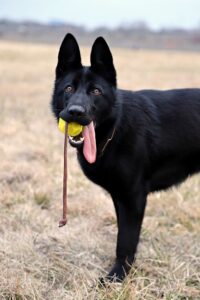You may have noticed your German Shepherd is more in to keep away than retrieving! This is just a quality of the breed but you can learn how to teach fetch to your German Shepherd. Just don’t ever let yourself be pulled into a game of keep away!
Table of Contents
Introduction
German Shepherds, known for their intelligence, loyalty, and versatility, are one of the most beloved dog breeds around the world. Though when it comes to fetch, German Shepherds may not be as instinctively inclined as Labrador Retrievers or Golden Retrievers. But for those who wish to engage in a spirited game of fetch with their GSD, the process can be both rewarding and a bonding experience. Here’s a comprehensive guide to teaching your German Shepherd to fetch, leveraging their unique characteristics and traits.
Preparing for Fetch Mastery
Before you begin the fetch training, it’s important to understand that German Shepherds are not natural retrievers and their approach to play can often be more focused on herding or guarding or in the case of fetch you may find your German Shepherd would rather play keep away! However, with the right approach, your German Shepherd can learn the joy of this classic canine pastime.
Understanding the Lack of Retrieving Instincts
Unlike some other breeds, GSD’s were primarily bred as working dogs, which often encompassed tasks like defense, tracking, and herding. While your average retriever may come to fetch instinctively the game of fetch may not always be intuitive for your German Shepherd! . Tailoring your approach to their temperament is key to success.
Selecting the Right Toy
Choosing a fetch toy is critical. It should be something your dog is interested in but also something safe and durable. Balls, frisbees, and specifically designed fetch toys are typically good options. Always consider the size of the toy to match your dog’s jaws.
The Right Mindset
Ensuring your German Shepherd is in a positive, alert, and playful frame of mind before each training session is crucial in setting the right tone and expectations. A good walk or quick play to burn off some energy can help focus them on the training.
Fundamentals of Training a Fetch-Ready GSD
Positive Reinforcement
GSDs are incredibly responsive to positive reinforcement. Be liberal with the treats and praise when they do something right. This not only encourages the desired behavior but also solidifies the bond between you and your dog.
Consistency is Key
Establish a particular time and place for training. The more consistent you are with your cues and rewards, the quicker your GSD will understand the commands and learn the significance of the fetch game.
Patience in Training Sessions
German Shepherds can be strong-willed and it might take time for them to grasp the concept of fetch and even after they do understand they may very well decide fetch is simply not as much fun as keep away. A patient and calm demeanor will go a long way in helping them pick up the game without associating it with stress or pressure.
The Step-by-Step Guide to Fetch
Step 1: Getting Acquainted with the Toy
Start by simply getting your dog interested in the toy. Hold it out and allow your dog to sniff and investigate. Incorporate the toy into their playtime without introducing the concept of throwing it just yet.
Step 2: The Launch
When your dog seems interested, throw the toy a short distance, perhaps just a few feet away. Encourage your dog to go after it with enthusiasm, using a happy and inviting tone of voice.
Step 3: The Return
When your GSD picks up the toy, encourage them to come back to you. Use an excited voice, pat your legs, or even take a few steps back to urge them towards you. It’s best at this point to have a lead on you GSD. Also when he brings it back do not take it from him! Play tug and let him win each time. You want to build up value in the return.
Step 4: Relinquishing the Object
The final step is teaching your dog to release the toy into your hands. Use the command “drop” or “give” as you hold out your hand. When they do so, praise and reward with a treat. if your GSD does not want to relinquish the object do not take it from him. Trade him for a treat.
Keep in mind short frequent games is better than playing to the point he looses interest.
Using Two Balls to Teach Fetch
This is how I exercise Jasper. I use two balls on a rope. I throw the first one and he chases after it. I then show him the second and only throw that when he brings back and drops the first one. I do not pick up the first ball until he leaves for the second. This is a way to exercise your dog without wearing yourself out. Eventually you will work your way up to requiring the dog to actually bring it to you at your feet but take your time with this. It may take weeks of playing like this before you get him to actually bring the ball directly to you.
When you are ready to stop playing say all done and let the dog carry the ball in his mouth to the door or until he drops it.
Troubleshooting Common Issues
Problem #1: The Run Away
If your dog runs to the toy but doesn’t return, consider using a long line to gently guide them back initially. Gradually phase this out as they become more inclined to return on their own. What ever you do don’t chase him and don’t grab at the ball.
Problem #2: The Chomp and Run
For GSDs that pick up the toy but drop it before returning, work on “leave it” and “drop it” commands. Encourage a soft grip on the toy by playing tug-of-war and rewarding for gentle disengagement.
Problem #3: The Uninterested Shepherd
For dogs showing no interest, try using high-value treats as rewards for engaging with the toy. Sometimes, it’s a matter of finding the right incentive.
Taking Fetch to the Next Level
Increasing the Challenge
Once your German Shepherd has mastered the basics, gradually start throwing the toy further. Through this incremental approach, they’ll learn to venture out and return with the toy despite the added distance.
Introducing Commands
Words like “fetch,” “go get it,” “bring it back,” and “drop it” can become a part of your fetch training. Be consistent with the cues and associate them with the correct actions.
Maintaining Interest
Variety is key to maintaining your GSD’s interest. Introduce different types of toys and surfaces. Also, play fetch in various locations like during walks, in the park, or your backyard to keep the game stimulating. Always stop before your dog looses interest. To begin with 1-2 minutes is plenty of training time.
Incorporating Fetch into Daily Routines
Make fetch a part of your daily exercise and play routines. A GSD that has plenty of physical and mental stimulation is a happier and more obedient dog. Regular play sessions help keep the training fresh in their mind.
Conclusion
Teaching fetch to your German Shepherd is not an overnight process. It requires dedication, patience, and a deep understanding of your dog’s breed-specific behavior. By approaching the training with a positive mindset, employing consistent principles, and taking it step by step, you can turn your steadfast GSD into a fetching champion. Remember, the key to success lies in the bond you build with your dog while engaging in this playful activity. Enjoy the process, celebrate the small victories, and form lasting memories as you and your German Shepherd master the art of fetch.


